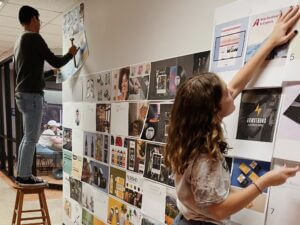From filmmaking in Cambodia to studying Native American pictographs with multispectral imaging, ACU students are putting their knowledge into practice every day.

Experiential learning – or learning by doing – is an important part of an ACU education and is built into the curriculum for all undergraduate majors from their freshman through senior years. Their academic experience culminates with the Senior Capstone, in which students nearing graduation complete a project integrating what they’re taught in the classroom with real-life experience.
ACU’s Senior Capstone was recognized as one of the top in the nation in the U.S. News and World Report rankings for 2025, ranking at #21, making it the highest-ranking university in Texas in the category.
“The American Association of Colleges and Universities presents integrative learning as one of the essential learning outcomes for students in the 21st century, and we chose to make integrative learning a part of our general education requirements at several places in the curriculum,” says Dr. Jessica Smith, assistant provost.
Faculty design the Senior Capstone experiences for each major. One of the best parts of the capstone experiences is how much they vary and how well they represent their disciplines, says Smith. For example:
- Art students take a Senior Exhibition series of courses that starts with ART 494. They work in small groups to curate their own art shows that are open to the public and display their portfolios of work.
- Engineering students take a Senior Clinic series of courses that starts with ENGR 430. The students work in teams with a real client to solve a problem for a company.
- Teacher Education students take a class management course and then move into student teaching for their capstone experience.

Journalism graduate Londyn Gray (’23), who is now working on her M.Div. degree in ACU’s Graduate School of Theology, created a documentary of a summer mission trip to Cambodia as her capstone project.
“The reason I wanted to become a journalist in the first place was to engage in human connection and tell unheard stories,” she says. “I had somewhat lost sight of this vision, but my capstone project reignited my passion for storytelling.”
Physics majors Ben Camp and Sidney Osae-Osante are working on a project using multispectral photography to enhance the visibility of Native American pictographs at an ancient ceremonial site in Paint Rock, Texas. The technology, originally used to map details of the earth from space, captures wavelengths of color not visible to the human eye and may allow faded or obscured drawings to be studied.
“This technique we’re looking at is exciting for us, because it’s not really been used on indigenous art or rock art,” says Camp.
“I love that we get to go to the site and actually interact with the art,” he says. “Also, it connects with the broader indigenous community who goes out there and the other people working on the project. So I’ve been really thankful to be able to engage in that community.”
Every capstone experience includes a required paper that demonstrates students’ information literacy, an assignment that requires students to think critically about faith and vocation within their discipline, and a comprehensive inventory of every student’s skills and accomplishments, Smith says.
“This means that all of our students leave ACU with the chance to both know and do in their discipline, which shapes their confidence and career readiness and gives one final opportunity to integrate faith and learning,” she adds.
And that’s the key to the capstone’s success.
What Gray took away from her trip to Cambodia will follow her throughout her career.
“I best learned of the power of journalism by being among those whose stories I want to tell,” she says. “I learned by doing and being, and that’s invaluable.”
– Robin Saylor
